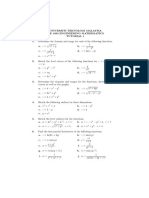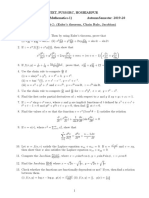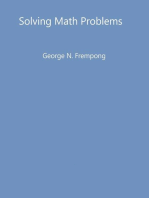Assignment for Calculus
Uploaded by
aryarajsinhthakor1209Assignment for Calculus
Uploaded by
aryarajsinhthakor1209Partial Derivative
1. If u = f ( x 2 + 2 yz , y 2 + 2 zx), Prove that
u u u
( y 2 − zx) + ( x 2 − zy ) + ( z 2 − xy ) =0.
x y z
2. 2u 2u 2u
If u = log( x 2 + y 2 + z 2 ) , prove that x =y =z .
yz zx xy
2u 2u 2u
( )
3. 4
If u = log x3 + y 3 − x 2 y − xy 2 , prove that + 2 + 2 =− .
x xy y ( x + y)
2 2
4. u u u
If u = f ( x − y, y − z, z − x) , then show that + + = 0.
x y z
5. 𝑥 𝑦 𝑧 𝜕𝑢 𝜕𝑢 𝜕𝑢
If 𝑢 = 𝑓(𝑦 , 𝑧 , 𝑥) then show that 𝑥 𝜕𝑥 + 𝑦 𝜕𝑦 + 𝑧 𝜕𝑧 = 0.
6. State modified Euler’s theorem.
14 + y 14
−1 x
If u = sin 1 , prove that
x 6 + y 16
2u 2u 2 u
2
1
x2 + 2 xy + y = tan u [tan 2 u − 11] .
x 2
xy y 144
2
7. x+ y
If u = sin −1
x + y
; Prove that
2u 2u 2u 1
x 2 2 + 2 xy + y 2 2 = (tan 3 u − tan u )
x x y y 4
8. 12 1
−1 x +y 2
If u = cos ec then prove that
x 13 + y 13
u2
u
2
u2
tan u (13 + tan 2 u )
1
x 2 2 + 2 xy +y 2 =
x xy y 144
9. Find the equations of the tangent plane and normal line to the surface
2 x 2 + y 2 + 2 z = 3 at ( 2,1, −3) .
10. Find the equations of the tangent plane and normal line at the point (−2,1, −3)
x2 z2
to the ellipsoid + y2 + = 3.
4 9
11. Find the equation of the tangent plane and normal line to the surface 𝑥 2 +
𝑦 2 + 𝑧 2 = 3 at the point (1,1,1).
12. Find the extreme value of x3 + 3xy 2 − 3x 2 − 3 y 2 + 4 .
13. Find the extreme values of x 3 + 3xy 2 − 15 x 2 − 15 y 2 + 72 x .
Find the extreme values of the function f ( x, y ) = x + y − 3x − 12 y + 20 .
3 3
14.
15. Find the minimum value of 𝑥 2 𝑦𝑧 3 subject to the condition
2𝑥 + 𝑦 + 3𝑧 = 𝑎.
Partial differential equation
1. 1. Solve pz − qz = z 2 + ( x + y )
2
2. Solve yzp − xzq = xy
3. Solve ( z − y ) p + ( x − z )q = y − x
4. Solve x( y − z ) p + y ( z − x)q = z ( x − y )
2. Solve
1. p2 + q2 = 1
2. p − 3x 2 = q 2 − y .
p + q =1
3.
4. p − q2 = x − y
2
z 2 ( p2 z 2 + q2 ) = 1
5.
6. p (1 + q ) = qz
7. yp = 2 yx + log q
3. 1. Form a partial differential equation by eliminating the arbitrary function
f ( x + y + z , x 2 + y 2 + z 2 ) = 0.
2. Form a partial differential equation by eliminating by the arbitrary functions
from xyz = ( x + y + z ) .
3. Eliminate the arbitrary function from the equation z = xy + f ( x 2 + y 2 ) .
4. Form a partial differential equation by eliminating the arbitrary function
from F ( x 2 − y 2 , xyz ) = 0 .
Vector Calculus
1. Find directional derivative of = xy 2 + yz 2 at the point (2,-1,1) in the
direction of the vector iˆ + 2 ˆj + 2 kˆ .
2. Find the directional derivative of = xy 2 + yz 2 at point ( 2, −1,1) in the
direction of the vector iˆ + 2 ˆj + 2kˆ .
3. Find the directional derivatives of the function = xyz at the point (1,1,1) in
the direction of the vector iˆ + ˆj + kˆ
4. Show that F = ( y + z ) iˆ + ( z + x) ˆj + ( x + y ) kˆ, is irrotational and hence find its
scalar potential function.
5. Prove that the vector F = (3x + 2 y + 4 z )iˆ + (2 x + 5 y + 4 z ) ˆj + (4 x + 4 y − 8 z )kˆ is
both solenoidal and irrotational
6. If A = (ax 2 y + yz )iˆ + ( xy 2 − xz 2 ) ˆj + (2 xyz − 2 x 2 y 2 )kˆ is solenoidal, find the
constant a .
7. If F = 2 xyz iˆ + ( x 2 z + 2 y ) ˆj + x 2 y kˆ, then
I) If F is conservative, find its scalar potential
II) Find the work done in moving a particle under this force field from (0,1,1)
to (1,2,0).
8. Find the work done, when a force F = ( x 2 − y 2 + x ) iˆ − ( 2 xy + y ) ˆj moves a
particle from ( 0, 0 ) to the point (1,1) along y 2 = x .
9. A vector field is given F = ( x 2 − y 2 − x)iˆ − (2 xy + y ) ˆj . Show that the field is
irrotational and find its scalar potential.
10. Prove that F dr = 3 , where F = ziˆ + xjˆ + ykˆ and C is the arc of the curve
C
r = cos tiˆ + sin tjˆ + tkˆ from t = 0 to t = 2 .
11. Find the unit vector normal to the surface 𝑥 2 𝑦 + 2𝑥𝑧 2 = 8 at (1,0,2).
12. If 𝐹̅ = 3𝑥𝑦𝑖̂ − 𝑦 2 𝑗̂, evaluate ∮ 𝐹̅ ∙ 𝑑𝑟̅ where c is the arc of parabola 𝑦 = 2𝑥 2
from (0,0) to (1,2).
13. i. Show that 𝐹̅ = 3𝑦 4 𝑧 2 𝑖̂ + 4𝑥 3 𝑧 2 𝑗̂ − 3𝑥 2 𝑦 2 𝑘̂ is solenoidal.
ii. Prove that 𝐹̅ = 𝑦𝑧𝑖̂ + 𝑧𝑥𝑗̂ + 𝑥𝑦𝑘̂ is irrotational.
iii.
Ordinary differential equation
1. Check whether the given differential equation id exact or not
(x 4
− 2 xy 2 + y 4 ) dx − ( 2 x 2 y − 4 xy 3 + sin y ) dy = 0
Hence, find the general solution
2. dy
Solve ( x + 1) − y = e3 x ( x + 1)
2
dx
3. dy y
iv. Solve + = x3 y 3
dx x
4. (
Solve x + 3 xy
3 2
) dx + ( 3x 2
y + y 3 ) dy = 0
v. Hence, find the general solution
1
5. dy 1
vi. Solve + 2 y = 6e x
dx x
6. dy 2 y
vii. Solve + = x2 y 2
dx x
7. viii. Solve ye x dx + ( 2 y + e x ) dy = 0
8. dy
ix. Solve + 2 y tan x = sin x
dx
9. dy y y 2
x. Solve + =
dx x x 2
10. dy
xi.Solve + y sin x = ecos x
dx
11. dy 2
xii.Solve + y = y 2 x2
dx x
12. xiii. Solve ( D 2 − 9 ) y = 0, y ( 0 ) = 2, y ( 0 ) = −1
13. xiv. Solve ( D 2 + D ) y = x 2 + 2 x + 4
14. xv. Solve y − 3 y + 3 y − y = 4e x
15. ( )
Solve D + 9 y = 2sin 3 x + cos 3 x
2
16. (
Solve D − 1 y = xe
2
) x
17. (
Solve D + 3D + 2 y = sin 2 x
2
)
18. (
Solve D + 16 y = x + e
2
) 4 3x
+ cos 3x
19. Using Variation of parameters, Solve the following equations
1. (D 2
+ 1) y = cos ec x
2. y "+ 9 y = sec3x
3. y "+ a 2 y = tan ax
4. (D 2
+ 4 ) y = tan 2 x
d2y
5. + 9 y = tan 3x
dx 2
6. (D 2 + 4 y = cot 2 x)
7. y "− 3 y '+ 2 y = e x
20. Using method of Undetermined coefficients, solve the following equations
1. y "+ 4 y = 8 x 2
2. (D 2
− 2 D + 5 ) y = 25 x 2 + 12
3. y "+ 2 y '+ 10 y = 25 x 2 + 3
4. y "+ 4 y = 2sin 3 x
5. (D 2
− 2 D + 3) y = x3 + sin x
6. ( D 2 − 9) y = x + e 2 x − sin 2 x
Matrices
Que 1 Find Rank of the following matrix:
5 3 14 4 1 4 3 −1
1.
0 1 2 1 2.
2 0 3 1
1 −1 2 0 4 8 9 −1
0 6 7 −2 1 3
3.
−5 4 2 4.
1 4 5
1 −2 0 0 1 2
1 2 3 1 2 −1 3
5.
4 6 8 6.
3 4 0 −1
3 4 5 −1 0 −2 7
Que 2 Find Inverse of the following matrix by Gauss Jordan Method
1 2 3 2 3 4
4 3 1
1.
2 5 3 2.
1 0 8 1 2 4
8 4 3 0 1 2
3.
2 1 1 4. 1 2 3
1 2 1 3 1 1
1 0 1 1 2 3
2 3 0
5.
−1 1 1 6.
0 1 0 0 1 2
Que 3 Solve the following system of equations by Gauss Elimination Method
x + y + 2z = 9 x− y+z =3
1. 2 x + 4 y − 3 z = 1 2. 2 x − 3 y + 5 z = 10
3x + 6 y − 5 z = 0 x + y + 4z = 4
x + 2y + z = 8 4x − 2 y + 6z = 8
3. 2 x + 3 y + z = 13 4. x + y − 3 z = 1
x + y + 0z = 5 15 x − 3 y + 9 z = 21
x − 2y + z = 4 3 x + y − 4 z = 13
5. 3x + 5 y + z = 6 6. 2x − 3y + 7z = 5
6x − y + 4z = 2 2 x + 19 y − 47 z = 32
Que 4 Solve the following system of equations by Gauss Jordan Method
x + y + 2z = 8 x+ y+z =6
1. − x − 2 y + 3z = 1 2. x + 2 y + 3z = 14
3x − 7 y + 4 z = 10 2 x + 4 y + 7 z = 30
2x + 2 y + 2z = 0 −2 y + 3 z = 1
3. −2 x + 5 y + 2 z = 1 4. 3x + 6 y − 3 z = −2
8 x + y + 4 z = −1 6 x + 6 y + 3z = 5
Que 5 Find Eigen values and Eigen vectors of the following
5 4 2 0
1. 1 2 2.
2 3
4 6 6 1 0 −1
3.
1 3 2 4.
1 2 1
−1 −4 −3 2 2 3
8 −6 2 0 1 1
5.
−6 7 −4 6.
1 0 1
2 −4 3 1 1 0
1 2 2 0 1 0
7.
0 2 1 8.
0 0 1
−1 2 2 1 −3 3
You might also like
- EContent 1 2023 06 07 09 59 44 Assignmentforslowlearner1pdf 2023 05 10 09 19 33No ratings yetEContent 1 2023 06 07 09 59 44 Assignmentforslowlearner1pdf 2023 05 10 09 19 332 pages
- 2024-25 Tute II (MAN101) - 240830 - 103100No ratings yet2024-25 Tute II (MAN101) - 240830 - 1031003 pages
- Instructors: Dr. J. C. Kalita,: X Xy X +yNo ratings yetInstructors: Dr. J. C. Kalita,: X Xy X +y3 pages
- ENGG1003 Mathematics I Advanced Calculus Tutorial-1: F X X F X XX F y X XyNo ratings yetENGG1003 Mathematics I Advanced Calculus Tutorial-1: F X X F X XX F y X Xy1 page
- Practice Questions On Partial Differentiation and Homogeneous FunctionsNo ratings yetPractice Questions On Partial Differentiation and Homogeneous Functions2 pages
- Department of Mathematics MAL 110 (Mathematics I) Tutorial Sheet No. 3 Several Variables, Maxima/Minima and Euler's TheoremNo ratings yetDepartment of Mathematics MAL 110 (Mathematics I) Tutorial Sheet No. 3 Several Variables, Maxima/Minima and Euler's Theorem2 pages
- Assignment Euler's Theorem Chain Rule JacobianNo ratings yetAssignment Euler's Theorem Chain Rule Jacobian2 pages
- CBSE Worksheets For Class 12 Maths Continuity and Differentiability Assignment 02 PDFNo ratings yetCBSE Worksheets For Class 12 Maths Continuity and Differentiability Assignment 02 PDF2 pages
- Solution To Practice Problems For Test 2No ratings yetSolution To Practice Problems For Test 26 pages
- CBSE Worksheets For Class 12 Maths Continuity and Differentiability Assignment 02 - KST Study PointNo ratings yetCBSE Worksheets For Class 12 Maths Continuity and Differentiability Assignment 02 - KST Study Point4 pages
- Unit-II. 21mab101t - Calculus and Linear Algebra 2023-2024pptxNo ratings yetUnit-II. 21mab101t - Calculus and Linear Algebra 2023-2024pptx84 pages
- Unit-II. 21mab101t - Calculus and Linear Algebra 2023-2024pptxNo ratings yetUnit-II. 21mab101t - Calculus and Linear Algebra 2023-2024pptx84 pages
- Exercises in Biostatistics: Drawing Inferences (One Sample)No ratings yetExercises in Biostatistics: Drawing Inferences (One Sample)2 pages
- Quadratic Equations: Objective ProblemsNo ratings yetQuadratic Equations: Objective Problems29 pages
- ISA Transactions: Peyman Sindareh Esfahani, Jeffrey Kurt PieperNo ratings yetISA Transactions: Peyman Sindareh Esfahani, Jeffrey Kurt Pieper11 pages
- (Projects) en Developing Pupil Competences Through ETwinningNo ratings yet(Projects) en Developing Pupil Competences Through ETwinning60 pages
- Athematics Yllabuses: Secondary One To FourNo ratings yetAthematics Yllabuses: Secondary One To Four46 pages
- Tugasan Kumpulan Set A SM025 Soalan 2019 - 2020 PDFNo ratings yetTugasan Kumpulan Set A SM025 Soalan 2019 - 2020 PDF6 pages
- 03 - TS - CH-3 Polynomials - Sa-1 Booklet - 2023-2024No ratings yet03 - TS - CH-3 Polynomials - Sa-1 Booklet - 2023-20249 pages
- Previous Year Question Paper Summative Assessment-Ii Class: Vii Subject: MathsNo ratings yetPrevious Year Question Paper Summative Assessment-Ii Class: Vii Subject: Maths3 pages
- Circular Motion, 2D Motion, Mechanics Revision Notes From A-Level Maths Tutor100% (2)Circular Motion, 2D Motion, Mechanics Revision Notes From A-Level Maths Tutor6 pages
- 1.write A Program To Print ' 100 Times Using Linefeed and Carriage Return. CodeNo ratings yet1.write A Program To Print ' 100 Times Using Linefeed and Carriage Return. Code7 pages
- 207 Python Programming Exercises Volume 1 - Become A Pro Python DeveloperNo ratings yet207 Python Programming Exercises Volume 1 - Become A Pro Python Developer199 pages
- EContent 1 2023 06 07 09 59 44 Assignmentforslowlearner1pdf 2023 05 10 09 19 33EContent 1 2023 06 07 09 59 44 Assignmentforslowlearner1pdf 2023 05 10 09 19 33
- ENGG1003 Mathematics I Advanced Calculus Tutorial-1: F X X F X XX F y X XyENGG1003 Mathematics I Advanced Calculus Tutorial-1: F X X F X XX F y X Xy
- Practice Questions On Partial Differentiation and Homogeneous FunctionsPractice Questions On Partial Differentiation and Homogeneous Functions
- Department of Mathematics MAL 110 (Mathematics I) Tutorial Sheet No. 3 Several Variables, Maxima/Minima and Euler's TheoremDepartment of Mathematics MAL 110 (Mathematics I) Tutorial Sheet No. 3 Several Variables, Maxima/Minima and Euler's Theorem
- CBSE Worksheets For Class 12 Maths Continuity and Differentiability Assignment 02 PDFCBSE Worksheets For Class 12 Maths Continuity and Differentiability Assignment 02 PDF
- CBSE Worksheets For Class 12 Maths Continuity and Differentiability Assignment 02 - KST Study PointCBSE Worksheets For Class 12 Maths Continuity and Differentiability Assignment 02 - KST Study Point
- Unit-II. 21mab101t - Calculus and Linear Algebra 2023-2024pptxUnit-II. 21mab101t - Calculus and Linear Algebra 2023-2024pptx
- Unit-II. 21mab101t - Calculus and Linear Algebra 2023-2024pptxUnit-II. 21mab101t - Calculus and Linear Algebra 2023-2024pptx
- Exercises in Biostatistics: Drawing Inferences (One Sample)Exercises in Biostatistics: Drawing Inferences (One Sample)
- ISA Transactions: Peyman Sindareh Esfahani, Jeffrey Kurt PieperISA Transactions: Peyman Sindareh Esfahani, Jeffrey Kurt Pieper
- (Projects) en Developing Pupil Competences Through ETwinning(Projects) en Developing Pupil Competences Through ETwinning
- Tugasan Kumpulan Set A SM025 Soalan 2019 - 2020 PDFTugasan Kumpulan Set A SM025 Soalan 2019 - 2020 PDF
- 03 - TS - CH-3 Polynomials - Sa-1 Booklet - 2023-202403 - TS - CH-3 Polynomials - Sa-1 Booklet - 2023-2024
- Previous Year Question Paper Summative Assessment-Ii Class: Vii Subject: MathsPrevious Year Question Paper Summative Assessment-Ii Class: Vii Subject: Maths
- Circular Motion, 2D Motion, Mechanics Revision Notes From A-Level Maths TutorCircular Motion, 2D Motion, Mechanics Revision Notes From A-Level Maths Tutor
- 1.write A Program To Print ' 100 Times Using Linefeed and Carriage Return. Code1.write A Program To Print ' 100 Times Using Linefeed and Carriage Return. Code
- 207 Python Programming Exercises Volume 1 - Become A Pro Python Developer207 Python Programming Exercises Volume 1 - Become A Pro Python Developer

























































































